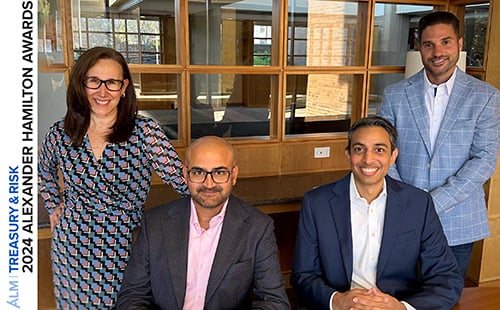 As companies go about their business, one of the big risks they face is among the most mundane: customers paying them late, or not paying them at all. And credit teams, which are charged with handling this risk, are finding that as the world speeds up,
As companies go about their business, one of the big risks they face is among the most mundane: customers paying them late, or not paying them at all. And credit teams, which are charged with handling this risk, are finding that as the world speeds up,
"In the old days, when everything was manual, the speed was just a function of whatever your department policies were," said Scott Tillesen, a speaker and trainer on the topic of credit management. "But now we're talking about stuff that's measured in minutes, not days.
"You get a phone call, and you're supposed to be able to digest all the information and make a decision," said Tillesen, who prior to retiring was vice president of credit for the Americas at Tech Data, a Fortune 100 company. "If a lot of this stuff isn't predigested and available, you can't make that instantaneous decision."
Recommended For You
René Donko, a member of the executive board at SOPLEX, a German technology company, agrees that credit decisions are happening faster. "Business processes speed up, and the credit manager has to be very quick in making his decisions," he said.
The accelerated pace puts the focus on technology that can help credit managers move quickly.
Underlying credit teams' efforts are their companies' enterprise resource planning systems, which contain essential information on billing and payments. ERP systems have credit modules, but those modules don't provide everything that a credit team needs.
While an ERP system may know which invoices are past due, it probably doesn't have a function that alerts members of the credit team to follow up with the customers that have past-due invoices, Tillesen noted. Nor would an ERP system let a credit group differentiate between the collection strategies it uses for various accounts, or help it to handle deduction management.
The shortcomings of ERP systems mean that bigger credit groups have to go outside their ERP suite for additional tools, just as they go outside it for additional data, Tillesen said.
The information that a credit group gathers on customers goes far beyond what's contained in an ERP system. There are the credit reports from vendors like Dun & Bradstreet, as well as financial statements that customers provide and documents related to any security interest the company arranges with a customer, such as a guarantee. There's also information gathered from industry-specific groups of credit executives who share data about common customers.
Austin Morris, a principal at PwC, said the challenges facing credit groups include the aggregation of that information—"just pulling all the data together in an automated format where you have the right information to make a good decision."
At the sophisticated end of the scale, that aggregation could include a mechanism that allows the credit group to use data to come up with a numerical credit score for each customer, which provides a more consistent way of assessing customers' credit risk, Morris said.
A survey of 110 treasury, finance, and risk professionals conducted last summer by Treasury & Risk and Moody's Analytics found that 57.4% of the companies surveyed generated an internal risk score or credit rating.
Tillesen said companies that use credit scoring combine information that could include the company's past-due experience with a customer, the customer's credit rating from Dun & Bradstreet or another firm, and information on the customer's finances, such as its net worth or cash flow, to create "a credit stew that pumps out an answer.
"If you have thousands of accounts to manage, you need some sort of automated decision-making these days," he said.
SOPLEX's Donko said that companies need to be able to adjust the way they compute those scorecards on customers' creditworthiness to reflect factors like the changing state of the economy.
He noted that in Germany five years ago, in the wake of the financial crisis, a customer that paid after 30 days might be right in line with the average. But these days, the economy is strong, and "all the customers in Germany pay two days before" the bill is due, Donko said. "So a customer with five- or 10-days' delay is a bad customer, and a customer with 30-days' delay is a very bad customer. That's why scorecards have to be adjusted."
If you have thousands of accounts to manage, you need some sort of automated decision-making these days.
—Scott Tillesen, speaker and trainer
Supplementing the ERP
One way that credit departments can deal with the shortcomings of ERP credit modules is by bringing in a software development company to enhance the module.
"What they do is a wrapper," Tillesen said. The wrapper goes around the ERP system's credit module, and once the modification is completed, users can't distinguish it from the rest of the ERP system.
Companies can also buy specialist credit modules that are designed to work with specific ERP systems.
For example, SOPLEX makes a credit module for SAP ERP systems. (SOPLEX was acquired late last year by Hanse Orga Group, which makes a treasury module for SAP systems.)
SOPLEX's solution is "like an accelerator to the SAP system," Donko said. "It's highly integrated within SAP, and it supports all the needs of modern credit management."
The work the SOPLEX software handles falls into three main areas: gathering, updating, and analyzing customer credit data; supporting credit management processes like credit limit approvals; and managing credit checks. Regarding the latter area, Donko noted that the SAP system automatically blocks sales orders if a customer has exceeded its credit limit. "These blocked sales orders have to be checked and approved by the credit manager and released so the sales agent can make the order," he said.
SOPLEX can organize the credit department's work flows, letting the credit manager know what tasks need to be accomplished, like releasing a blocked sales order or retrieving new information, Donko said. "These processes can be defined in a virtual engine to automate the process, because it's not possible to maintain all this manually."
However, one size does not fit all because credit and collections work differently in different countries.
"Collection processes in Germany are different to the collection processes in Spain, and they're very different to the collection processes in the United States," he said. "In the United States you have a lot of phone collections—you're looking for the direct connection to your customer. The Germans love to write letters—they write a first dunning letter, a second dunning letter, a third dunning letter. The software has to support all these different mentalities and local processes."
Access to Resources
Credit managers' access to the technology they need can be hampered by the fact that the credit department is far from the head of the line when it comes to getting the resources it needs.
"Credit is typically a back-office function that doesn't get as much attention as other parts of the organization," PwC's Morris said, adding that that applies both to help from the IT group and corporate funding for projects.
The central role of the ERP system means credit departments should make sure they have a voice in any company decisions about ERP systems. But Tillesen says they have to speak up to get their concerns heard.
"Credit is generally not first, second, or third in an IT department's thoughts on who can benefit from IT efforts," he said. "Typically credit management needs to be advocates for themselves in promoting the needs of their department to get the attention."
Companies are certainly wanting to go more automated so they can have control and visibility over the decisions that are being made as far as credit.
—Darrell Horton, Aristocrat Technologies
Pulling in Data
Most companies use information from a credit bureau, such as Dun & Bradstreet, to judge a customer's creditworthiness. Veronica Wills, U.S. working capital practice leader at the Hackett Group, said companies whose customers are smaller, mom-and-pop firms might want to consider some of the smaller providers of credit data, like Equifax and Experian, that have built up their information on small businesses.
Wills noted, though, that some of the most valuable information about its customers resides in a company's own systems—the data about the speed of the customer's payments over time.
Many companies reevaluate their customers once or twice each year, depending on the amount of business they transact with that customer, with smaller customers getting a look-see every year or so and large customers being reassessed every six months.
But if a company takes advantage of its own data on payments, "if you automate, you can evaluate every month, and if there is a change in a month that exceeds a certain tolerance, you can look at them manually," Wills said. "So you're doing a credit risk assessment every month, instead of every six months—which may be way too long to mitigate any exposure you have in terms of bad debt—and minimizing manual labor."
The process could be particularly valuable for companies with large numbers of customers, Wills said, but added that she doesn't see a lot of the companies that are Hackett's clients doing this.
According to the Treasury & Risk/Moody's Analytics survey, just 8% of the companies surveyed refresh their credit assessments of customers more frequently than once a month. The largest portion, 37%, reevaluate each customer on an annual basis, while 27% do so quarterly and 16% monthly.
Darrell Horton, director of credit at Aristocrat Technologies, a maker of slot machines, said that when it comes to existing customers, his own data on how they pay him "is probably going to carry the most weight" in his credit assessments.
"How the customer pays others in my industry carries the second most weight," he said. "Third, financials. Fourth, credit bureaus."
But Horton cautioned about reading too much into small changes in the timing of a customer's payments.
"There's so many different things that could weigh on that," he said. "I may not be delivering the invoices properly so they can pay them on time. Sometimes changes in timing are just a matter of changes in the customer's staff."
Single System
The efficiencies of working within a single system suggest technology should evolve toward gathering all the information a credit team needs within one system, Tillesen said.
"Let's say you have your ERP system up to find your customer's past-due balance, and then go to a different system to find a financial statement you've saved, and then dial up D&B to find a report, and then go elsewhere," he said.
"You're opening and closing modules to digest all this information in your head. People have gravitated to that if they haven't had the time and money to consolidate those things," he said. "Where the world is going, and it's largely there for some, is to put that information in one system."
"It's surprising how inefficient it is for professionals to be at their desktop and have to key around between applications," Tillesen added. "When we put them all into one system, the productivity just skyrockets."
Having everything in a single system can also help a credit team be more consistent, since it guarantees everyone is looking at the same, readily available information.
Tillesen also emphasized the importance of a dashboard, "one that conveys the most important information very conveniently."
Ideally, he said, a credit solution will have two different dashboards—one that is used for customer credit analysis and the other that looks at the entire credit management team's performance. "How's my whole department doing with aging?" Tillesen said. "What is the current status of accounts, and how are they performing against KPIs?"
Going Mobile
Mobile capabilities are slowly coming to credit risk management technology, in response to the mobility of employees.
Tillesen is enthusiastic about mobile access, calling it "a natural fit" for credit team members and the sales department.
He cited the example of a meeting offsite where a customer wants to know whether a particular order has been released. A mobile application would provide "the ability to go in and spot that order in the system, and tell them there and then that it has been released or hasn't," he said. "It would be really nice to pull out your phone and release those orders in a mobile setting like that.
"You've got to be able to make fast decisions all the time, and the world has moved to those devices we carry around," Tillesen said.
Donko noted that salespeople usually don't work with SAP, which leaves them without direct access to the credit system. "That's why it's very important that credit management goes mobile," he said.
SAP Fiori apps support interfaces to business applications, so that, for example, a salesman could work on a credit limit application on a tablet or smartphone and then send that via the connection to the SAP system, Donko said.
Previously, the salesperson would have filled out a paper form and the credit manager would have had to enter the information manually into the system, Donko said. "Now, at this time, it is possible to digitalize the whole process."
Digitalization is a huge trend in credit management. Process automation is a huge trend.
—René Donko, Soplex
Looking Ahead
Donko cited various technology advances that are influencing credit solutions. "Digitalization is a huge trend in credit management," he said. "Process automation is a huge trend. And, of course, to make processes mobile like credit limit approvals, these are really the huge trends in credit management at this time."
Donko also noted that in the last two or three years, companies have been extending the kinds of evaluations they do on customers to their suppliers.
He noted, though, that a supplier rating system uses different criteria. While such a system would gather a report from a credit agency on a supplier, it would also assess factors like quality management, whether the company has certain certificates, and whether it delivers orders in a timely manner.
PwC's Morris cited both big data and the cloud as promising technologies for credit solutions. "I think the credit part of an organization is going to continue to be a benefactor of developments in technology like that," he said. "It's going to give you the ability to have all the recent information about a customer and pull it together in a meaningful way so you can make a good decision."
At this point, there's a wide range in the extent to which companies have automated their credit processes. Aristocrat Technologies' Horton suggested that the shift to automation may be slowed by older credit managers who are accustomed to working on paper and may be leery of relying on technology.
"As younger and a little more tech-savvy credit managers come into play, you'll see more and more automation," he predicted. "Companies are certainly wanting to go more automated so they can have control and visibility over the decisions that are being made as far as credit."
© 2025 ALM Global, LLC, All Rights Reserved. Request academic re-use from www.copyright.com. All other uses, submit a request to [email protected]. For more information visit Asset & Logo Licensing.







